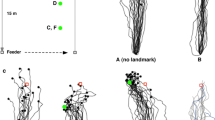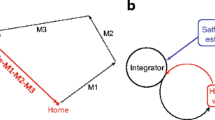Abstract
Path integration is a primary means of navigation for a number of animals. We present a model which performs path integration with a neural network. This model is based on a neural structure called a sinusoidal array, which allows an efficient representation of vector information with neurons. We show that exact path integration can easily be achieved by a neural network. Thus deviations from the direct home trajectory, found previously in experiments with ants, can not be explained by computational limitations of the nervous system. Instead we suggest that the observed deviations are caused by a strategy to simplify landmark navigation.
Similar content being viewed by others
References
Anderson C, Van Essen D (1987) Shifter circuits: a computational strategy for dynamic aspects of visual processing. Proc Nat Acad Sci USA 84: 6297–6301
Burgess N, O'Keefe J, Recce M (1992) Using hippocampal ‘place cells’ for navigation, exploiting phase coding. From Neuroprose Archive; can be retrieved by anonymous ftp from ftp://archive. cis. ohio-state. edu/pub/neuroprose
Collett T, Baron J (1994) Biological compasses and the coordinate frame of landmark memories in honeybees. Nature 368: 137–140
Görner P, Claas B (1985) Homing behaviour and orientation in the funnelweb spider Agelena labyrinthica. In: Earth F (eds) Neurobiology of arachnids. Springer, Berlin Heidelberg New York, pp. 277–297
Hartmann G, Wehner R (1995) The ant's path integration system: a neural model. Biol Cybern, this issue
Kohonen T (1982) Self-organized formation of topologically correct feature maps. Biol Cybern 43: 59–69
Mittelstaedt H (1985) Analytical cybernetics of spider navigation. In: Barth F (eds) Neurobiology of arachnids. Springer, Berlin Heidelberg New York, pp. 298–315
Mittelstaedt H, Eggert T (1989) How to transform topographically ordered spatial information into motor commands. In: Arbib M, Ewert J-P (eds) Visuomotor coordination: amphibians, comparisons, models, and robots. Plenum Press, New York, pp. 569–585
Mittelstaedt H, Mittelstaedt M-L (1982) Homing by path integration. In: Papi F, Wallraff HG (eds) Avian navigation. Springer, Berlin Heidelberg New York
Mittelstaedt M-L, Glasauer S (1991) Idiothetic navigation in gerbils and humans. Zool Jahrb Physiol 95: 427–435
Moller P, Görner P (1994) Homing by path integration in the spider Agelena labyrinthica Clerck. J Comp Physiol [A] 174: 221–229
Müller M (1989) Mechanismen der Wegintegration bei Cataglyphis fortis (Hymenoptera, Insecta). PhD thesis, University of Zürich
Müller M, Wehner R (1988) Path integration in desert ants, Cataglyphis fortis. Proc Natl Acad Sci USA 85: 5287–5290
O'Keefe J (1991) An allocentric spatial model for the hippocampal cognitive map. Hippocampus 1: 230–235
Redish A, Touretzky D, Wan H (1993) The sinusoidal array: a theory of representation for spatial vectors. In: Proceedings of the Computational Neurosciences Conference CNS 93. Kluwer Academic Publishers, Boston
Rumelhart D, McClelland J (1986) Parallel distributed processing, vols. 1 and 2. MIT Press, Cambridge, Mass
Schäfer M, Wehner R (1993) Loading does not affect measurement of walking distance in desert ants, Cataglyphis fortis. Verh Dtsch Zool Ges 86: 270
Seguinot V, Maurer R, Etienne A (1993) Dead reckoning in a small mammal: the evaluation of distance. J Comp Physiol [A] 173: 103–113
Touretzky D, Redish D, Wan H (1993) Neural representation of space using sinusoidal arrays. Neural Comput 5: 869–884
Wehner R, (1991) Visuelle Navigation: Kleinstgehirn-Strategien. Verh Dtsch Zool Ges 84: 89–104
Wehner R (1994) The polarization-vision project: championing organismic biology. Fortschr Zool 39: 103–143
Wehner R, Müller M (1993) How do ants acquire their celestial ephemeris function? Naturwissenschaften 80: 331–333
Wehner R, Srinivasan M (1981) Searching behaviour of desert ants genus Cataglyphis (Formicidae, Hymenoptera). J Comp Physiol [A] 142:315–338
Zeil J (1993a) Orientation flights of solitary wasps. I. Description of flights. J Comp Physiol [A] 172: 189–205
Zeil J (1993b) Orientation flights of solitary wasps. II. Similarities between orientation and return flights and the use of motion parallax. J Comp Physiol [A] 172: 207–222
Author information
Authors and Affiliations
Rights and permissions
About this article
Cite this article
Wittmann, T., Schwegler, H. Path integration — a network model. Biol. Cybern. 73, 569–575 (1995). https://doi.org/10.1007/BF00199549
Received:
Accepted:
Issue Date:
DOI: https://doi.org/10.1007/BF00199549




